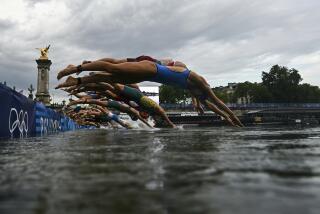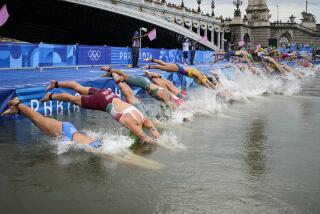Safety of Triathlon Is Defended After 2 Competitors Die in Separate Races
- Share via
Two people competing in separate triathlons died Sunday, one in an accident on the bicycle portion, the other collapsing after the half-mile swim. But despite the incidents, triathlon officials contended Monday that the sport is as safe as ever.
Steven McAdams, 30, was killed when he tried to pass another cyclist in the Governor’s Cup Triathlon in Boulder, Colo., fell and was run over by a pick-up truck. C. Frederick Kelley, 61, collapsed after the first leg of a competition in Canton, Conn.
Vern Scott, executive director of the Triathlon Federation USA, which sanctions nearly 400 of the 1,500 triathlons held in this country, said Monday that such fatalities are extremely rare.
“In the three years I’ve been keeping records, there has been one swimming fatality, one biking fatality and the death of one race management person,” Scott said.
Carl Thomas, who promotes the U.S. Triathlon Series for Bud Light (which did not promote either of the fatality-related events Sunday), said: “We’ve been in the business over six years, done over 60 events, pushing some 70,000 triathletes through high-density, urban development courses. And we’ve had no fatalities.”
Both agreed that the biking leg of a triathlon, a sport that also includes swims and runs of various lengths, is relatively dangerous because it is often impossible to close a road to traffic.
“Closing a road off is our recommendation,” Scott said. “However, considering the length of the various courses, the necessary proximity to both a water body and a running course, it’s not always possible. In this case (in Boulder), there was a lane closed off. But it’s not an uncommon situation to operate in lanes with traffic, using traffic cones (for separation).”
As to the collapse of the 61-year-old man in Connecticut, Scott contended it is impossible to “control the physical condition. All our literature indicates the demand on endurance, and that’s always a precaution. If you look at records on running, it happens almost every other week.”
Thomas, whose circuit features the established stars, said: “In 1981 there were perhaps 5,000 triathletes. . . . As the population increases, we’re reaching a broader audience. Something like this is almost inevitable.”
More to Read
Sign up for Essential California
The most important California stories and recommendations in your inbox every morning.
You may occasionally receive promotional content from the Los Angeles Times.










